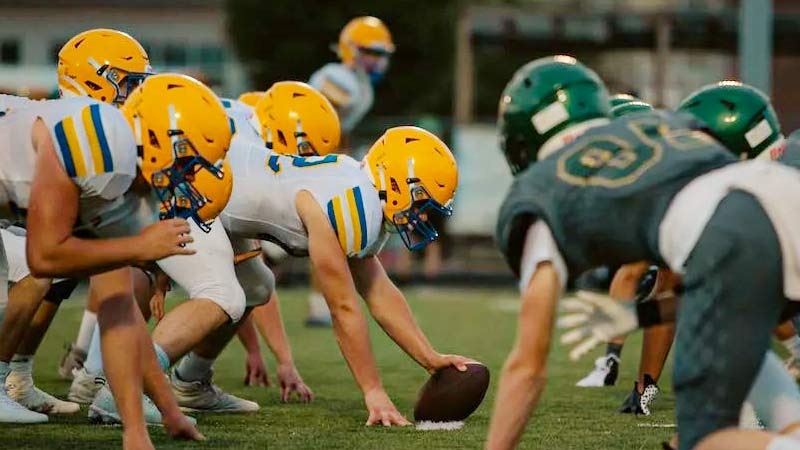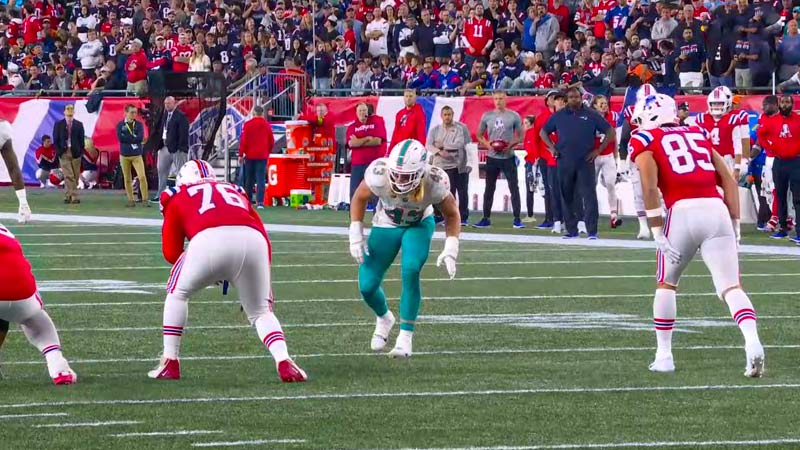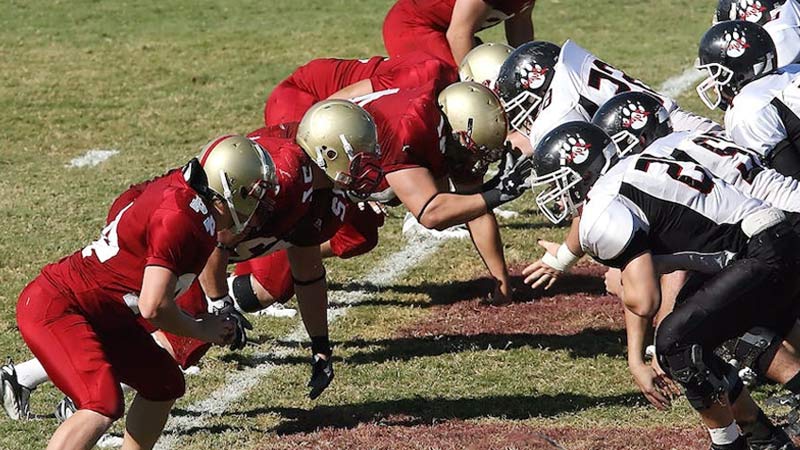In the realm of American football, the battle for supremacy often begins and ends at the line of scrimmage. The American Football Defensive Line, often unsung heroes of the game, holds the keys to defensive success.
This vital unit comprises gritty warriors who are tasked with stopping the run, pressuring the quarterback, and disrupting the rhythm of offensive plays.
As we delve into the intricacies of this position, we’ll explore the techniques, strategies, and mental fortitude that defensive linemen must possess.
From hand-fighting to pass-rushing maneuvers, their roles extend far beyond what meets the eye.
The significance of the defensive line sheds light on how this position stops the opponent’s advances and ignites the spirit and energy of an entire team.
Join us as we dive into the world of American Football’s Defensive Line and uncover the vital elements that shape gridiron success. Stay focused.
What Is Football Defensive Line?
The football defensive line is a critical component of American football’s defense.
Comprising three to four players, depending on the defensive scheme, their primary objective is to disrupt the opposing team’s offensive plays, particularly those involving running the ball or passing.
The defensive line is opposite the offensive line and consists of defensive tackles and defensive ends.
Defensive tackles are typically positioned in the line’s interior, aiming to clog running lanes and pressure the quarterback during passing plays.
Defensive ends, positioned on the edges, contain running backs and rush the passer.
These players must exhibit a combination of strength, speed, and technique to outmaneuver their offensive counterparts and make tackles or sack the quarterback.
An effective defensive line is crucial for a team’s overall defensive success as it sets the tone for disrupting the opponent’s offensive strategies.
Strategies of Football Defensive Line

Strategies for a football defensive line are essential for disrupting the opponent’s offense and creating opportunities for tackles, sacks, and turnovers.
Here are some key strategies employed by a defensive line:
Gap Control
Each defensive lineman is responsible for specific gaps in the offensive line. They must maintain gap integrity, ensuring that running backs cannot exploit openings between them.
Proper gap control limits the effectiveness of running plays and forces ball carriers into less favorable positions.
Pass Rush Techniques
Defensive linemen need a variety of pass-rushing techniques, such as the bull rush, swim move, and spin move.
These techniques help them shed blockers and pressure the quarterback, increasing the chances of sacks and disrupting passing plays.
Stunts and Twists
Linemen often execute coordinated stunts and twists, exchanging responsibilities to confuse the offensive line.
These maneuvers can create opportunities for linemen to get free and reach the quarterback or running back.
Reading the Play
Defensive linemen must read the play as it unfolds. They must recognize whether it’s a run or pass, react accordingly, and adjust their actions in real-time. This adaptability is crucial for stopping plays effectively.
Hand Placement and Leverage
Proper hand placement and leverage are fundamental in defeating blockers. Defensive linemen aim to get their hands inside the offensive lineman’s arms to control the engagement and maintain leverage.
Low pad level and leverage help them stay low and maintain a strong position in the trenches.
Creating Turnovers
In addition to pressuring the quarterback and stopping the run, defensive linemen should focus on creating turnovers.
This can be achieved by swatting at the ball, attempting to strip it from the ball carrier, or being aware of tipped passes that can result in interceptions.
Effective communication and coordination among the defensive linemen are also critical for executing these strategies.
Formations of Football Defensive Line
Football defensive lines can be organized in various formations to adapt to different offensive strategies and situations.
Here are some common defensive line formations:
4-3 Formation (Four Down Linemen, Three Linebackers)
- This traditional formation features four defensive linemen: two defensive tackles and two defensive ends.
- It often provides a strong pass rush while maintaining solid run defense.
- Well-suited for defending against balanced offenses.
3-4 Formation (Three Down Linemen, Four Linebackers)
- There are three down linemen in this formation, typically one nose tackle and two defensive ends.
- It’s employed for more flexibility and versatility, making it harder for the offense to predict which players will rush the passer or drop into coverage.
- Effective against both the run and the pass.
5-2 Formation (Five Down Linemen, Two Linebackers)
- In this formation, five down linemen are often used in short-yardage or goal-line situations.
- It provides extra strength and presence on the line of scrimmage, making it difficult for the offense to gain ground in short-yardage scenarios.
Nickel Formation (Four Down Linemen, One Additional Defensive Back)
- This formation is used to defend against pass-heavy offenses. It features four down linemen and five defensive backs.
- The extra defensive back provides better coverage against multiple wide receivers, while the four down linemen maintain some pass-rushing capabilities.
Dime Formation (Four Down Linemen, Two Additional Defensive Backs)
- Like the nickel formation, the dime formation incorporates two additional defensive backs for even stronger pass coverage.
- It is ideal for defending against long passing situations, such as third-and-long, but still maintaining some presence on the defensive line.
Bear Front Formation (Three Down Linemen, Three Linemen “Bear Crawl” Over Center)
- In the bear front, three defensive linemen line up in an unusual alignment, covering the center and both offensive guards.
- It is employed to clog running lanes and disrupt interior running plays, making it tough for the offense to run the ball effectively.
Each of these formations offers advantages and trade-offs, and coaches choose them based on their team’s specific strengths and weaknesses and the offensive strategies they are facing.
Training to Play in Football Defensive Line
Training to play on the football defensive line requires a combination of physical conditioning, technical skills, and mental preparation.
Here’s a comprehensive guide on how to prepare for this crucial position:
Strength and Conditioning
- Develop overall strength through weightlifting, emphasizing compound exercises like squats, deadlifts, bench presses, and power cleans.
- Focus on explosive movements and power development to help tackle and pass rushing.
- Include cardiovascular conditioning to improve endurance and recovery between plays.
Speed and Agility
- Work on agility drills to enhance lateral movement, change of direction, and the ability to pursue ball carriers.
- Incorporate sprinting drills to improve acceleration and top-end speed for passing, rushing, and pursuing the ball.
Hand Technique
- Master proper hand placement and hand-fighting techniques to disengage from offensive linemen and gain control.
- Practice striking and shedding blocks effectively to make tackles and disrupt passing plays.
Pass Rushing Skills
- Develop a repertoire of pass-rushing moves, such as the bull rush, swim move, spin move, and rip move.
- Work on reading the offensive line to anticipate snap counts and moves.
Run Stopping Techniques
- Focus on maintaining gap integrity, recognizing run plays, and shedding blocks to stop ball carriers.
- Learn to use leverage and maintain a low pad level to gain an advantage over offensive linemen.
Film Study
- Analyze game footage to understand the tendencies of opposing offensive linemen and the strategies of different offenses.
- Study playbooks and defensive schemes to deeply understand your role in different situations.
Mental Toughness
- Develop mental resilience, as playing on the defensive line often involves high-stress situations and physical confrontations.
- Stay disciplined, maintain composure, and focus on your responsibilities during the game.
Nutrition and Recovery
- Pay attention to nutrition to fuel your body for high-intensity workouts and games.
- Get enough rest and prioritize recovery methods like ice baths, stretching, and massage.
Continuous training and development are essential for success on the defensive line in football.
The position demands physical prowess, technical proficiency, and a deep understanding of the game.
Challenges to Play in Football Defensive Line

Playing on the football defensive line comes with its own set of unique challenges that players must overcome to excel in their roles.
Here are some challenges faced by defensive linemen:
Physical Demands
Defensive linemen engage in physically intense battles on every play. They must have the strength to take on multiple offensive linemen and the agility to pursue running backs or pressure the quarterback.
The continuous collisions and wear and tear on the body can lead to injuries and require rigorous conditioning to maintain peak performance.
Double Teams
Offensive linemen often double-team defensive linemen, with two blockers trying to overpower one player. This requires exceptional strength, technique, and leverage to avoid being neutralized, especially when trying to stop the run.
Mental Toughness
Defensive linemen must maintain mental composure in high-pressure situations. Maintaining gap discipline, recognizing play actions, and making split-second decisions are crucial. Coping with the frustration of being blocked or not always making high-profile plays can be mentally challenging.
Versatility
Defensive linemen are often required to perform various roles within different defensive schemes. Adapting to different formations, responsibilities, and playbooks can be demanding and necessitates a deep understanding of the game.
Injury Risk
The physical nature of the position exposes defensive linemen to a higher risk of injuries, particularly to the knees, shoulders, and hands. Injuries can significantly impact a player’s effectiveness and career longevity.
Maintaining Consistency
Defensive linemen need to be consistently disruptive in both run and pass situations. Overcoming the occasional double team, adapting to various offensive strategies, and maintaining stamina throughout a game require mental and physical consistency.
Despite these challenges, defensive linemen play a crucial role in a team’s success.
Importance of Football Defensive Line
The football defensive line is vital to a team’s defensive strategy, and its importance can’t be overstated.
Here are some elaborate points highlighting the significance of the defensive line in football:
Run Defense
The defensive line is the first line of defense against running plays. They must plug gaps, control the line of scrimmage, and tackle ball carriers.
Effective run defense starts with the defensive line, preventing the offense from gaining yards on the ground and forcing passing situations.
Pass Rush
Defensive linemen are crucial for generating pressure on the quarterback. Sacking the quarterback or forcing hurried throws can lead to turnovers and negative plays for the offense.
A strong pass rush can disrupt the timing of passing plays, making it difficult for the opposing team to execute their offense effectively.
Run Containment
Defensive ends, in particular, contain outside runs and prevent running backs from getting to the edge.
Maintaining containment is critical in preventing big runs and turning ball carriers back into the pursuit of the rest of the defense.
Occupying Blocks
Defensive linemen engage with offensive linemen to tie up blockers. They free up linebackers and defensive backs by occupying multiple blockers to make tackles and plays. This allows the defense to maintain gap integrity and limit the offense’s options.
Disruption of Plays
The defensive line’s penetration into the backfield can disrupt plays before they develop.
By creating chaos at the line of scrimmage, they can force running backs to change their intended path or force the quarterback into making quick decisions, often resulting in incomplete passes or interceptions.
Energy and Momentum
A strong defensive line can set the tone for a game by bringing energy and momentum to the defense. Big plays, tackles for loss, and sacks can galvanize the entire team and fans, creating a sense of momentum that can be a game-changer.
The defensive line serves as the foundation of a strong defensive unit. It contributes directly to stopping the run and pressuring the quarterback and indirectly by enabling linebackers and defensive backs to make plays.
FAQs
What is the primary role of the defensive line in American football?
The primary role of the defensive line is to disrupt the opposing team’s offensive plays.
They stop the run, pressure the quarterback, and create chaos at the line of scrimmage to make tackles, sacks, and turnovers.
How does the defensive line differ from the offensive line?
The defensive line stops the offense, while the offensive line protects the quarterback and creates running lanes.
Defensive linemen are tasked with penetrating the offensive line, while offensive linemen block to create protection.
What are some key techniques used by defensive linemen?
Defensive linemen employ various techniques, including hand-fighting, pass-rushing moves, gap control, and reading plays.
These skills are essential for engaging with offensive linemen, shedding blocks, and disrupting offensive plays effectively.
How does the defensive line impact a team’s defense?
The defensive line is crucial in setting the tone for a team’s defense.
Their ability to stop the run, pressure the quarterback, and create turnovers can significantly impact a game by limiting scoring opportunities and disrupting the opponent’s strategy.
What are the challenges faced by defensive linemen in American football?
Defensive linemen face physical demands, double teams, mental pressure, versatility requirements, injury risks, and the need for consistent performance.
Overcoming these challenges is essential for success in this pivotal position on the football field.
Wrapping Up
In the world of American football, the defensive line is the heartbeat of a formidable defense.
These warriors, endowed with strength, technique, and unwavering resolve, are the linchpin that holds the team’s fortunes. From plugging running lanes to applying relentless pressure on the quarterback, they shape the outcome of every game.
Their ability to read plays, outmaneuver offensive linemen, and create turnovers sets the stage for victory. Defensive linemen exhibit extraordinary resilience and intelligence as the unsung heroes in the trenches.
The essence of the American Football Defensive Line reveals the intricate dance that unfolds at the line of scrimmage. They are not just defenders but disruptors, motivators, and game-changers.
Through this journey into their world, we profoundly appreciate their pivotal role in the sport. In the realm of gridiron battles, the defensive line is the ultimate fortress, and their impact on the game is immeasurable.







